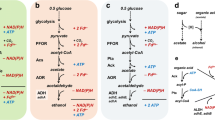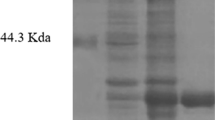Abstract
The anaerobic hyperthermophilic archaea Desulfurococcus amylolyticus, Hyperthermus butylicus, Thermococcus celer, Pyrococcus woesei, the hyperthermophilic bacteria Thermotoga maritima and Clostridium thermohydrosulfuricum and the aerobic mesophilic archaeon Halobacterium saccharovorum were grown either on complex media, on sugars or on pyruvate as carbon and energy sources. During growth acetate was formed as fermentation product by all organisms. The enzymes involved in acetyl-CoA formation from pyruvate and in acetate formation from acetyl-CoA were investigated:
-
1.
Cell extracts of all species, both archaea and bacteria, catalyzed the coenzyme A-dependent oxidative decarboxylation of pyruvate with viologen dyes or with Clostridium pasteurianum ferredoxin as electron acceptors indicating a pyruvate: ferredoxin oxidoreductase to be operative in acetyl-CoA formation from pyruvate.
-
2.
Cell extracts of all archaeal species, both hyperthermophiles (D. amylolyticus, H. butylicus, T. celer, P. woesei) and the mesophile H. saccharovorum, contained an acetyl-CoA synthetase (ADP forming), which catalyzes both acetate formation from acetyl-CoA and ATP synthesis from ADP and phosphate (Pi): Acetyl-CoA+ADP+Pi⇌Acetate + ATP+CoA. Phosphate acetyltransferase and acetate kinase could not be detected.
-
3.
Cell extracts of the hyperthermophilic (eu)bacteria T. maritima and C. thermohydrosulfuricum contained phosphate acetyltransferase and acetate kinase rather than acetyl-CoA synthetase (ADP forming).
These data indicate that acetyl-CoA synthetase (ADP forming) represents a typical archaeal property rather than an enzyme specific for hyperthermophiles. It is proposed that in all acetate forming archaea the formation of acetate and of ATP from acetyl-CoA, ADP and Pi are catalyzed by acetyl-CoA synthetase (ADP forming), whereas in all acetate forming (eu)bacteria these reactions are catalyzed by two enzymes, phosphate acetyltransferase and acetate kinase.
Similar content being viewed by others
Abbreviations
- DTE:
-
dithioerythritol
- Mes:
-
2-(N-morpholino)-ethane sulfonic acid
- Tris:
-
Tris-(hydroxymethyl)-aminomethane
- Tricine:
-
N-tris(hydroxymethyl)-methylglycine
- MV:
-
methylviologen
References
Aceti DJ, Ferry JG (1988) Purification and characterization of acetate kinase from acetate-grown Methanosarcina. Evidence for regulation of synthesis. J Biol Chem 263: 15444–15448
Adam RD (1991) The biology of Giardia spp. Microbiol Rev 55: 706–732
Aono S, Bryant FO, Adams MWW (1989) A novel and remarkably thermostable ferredoxin from the hyperthermophilic archaebacterium Pyrococcus furiosus. J Bacteriol 171: 3433–3439
Bode CH, Goebel H, Stähler E (1968) Zur Eliminierung von Trübungsfehlern bei der Eiweißbestimmung mit der Biurethmethode. Z Klin Chem Klin Biochem 5: 419–422
Bonch-Osmolovskaya EA, Slesarev AI, Miroshinichenko ML, Svetlichnaya TP, Alekseev VA (1988) Characteristics of Desulfurococcus amylolyticus n.sp. — a new extremely thermophilic archaebacterium isolated from thermal springs of Kamchatka and Kunashir Island. Mikrobiologiya 57: 94–101
Bonch-Osmolovskaya EA, Stetter KO (1991) Interspecies hydrogen transfer in cocultures of thermophilic Archaea. Syst Appl Microbiol 14: 205–208
Bouthier de la Tour C, Portemer C, Nadal M, Stetter KO, Forterre P, Duguet M (1990) Reverse gyrase, a hallmark of the hyperthermophilic archaebacteria. J Bacteriol 172: 6803–6808
Bouthier de la Tour C, Portemer C, Huber R, Forterre P, Duguet M (1991) Reverse gyrase in thermophilic eubacteria. J Bacteriol 173: 3921–3923
Bryant FO, Adams MWW (1989) Characterization of hydrogenase from the hyperthermophilic archaebacterium, Pyrococcus furiosus. J. Biol Chem 264: 5070–5079
Danson MJ (1988) Archaebacteria: the comparative enzymology of their central metabolic pathways. Adv Microb Physiol 29: 165–231
Decker K, Jungermann K, Thauer RK (1970) Energy production in anaerobic organisms. Angew Chem (int Edn) 9: 138–158
Dorn M, Andreesen JR, Gottschalk G (1978) Fermentation of fumarate and l-malate by Clostridium formicoaceticum. J Bacteriol 133: 26–32
Fiala G, Stetter KO (1986) Pyrococcus furiosus sp. nov. represents a novel genus of marine heterotrophic archaebacteria growing optimally at 100°C. Arch Microbiol 145: 56–61
Gottschalk G (1986) Bacterial metabolism, 2nd edn. Springer, Berlin Heidelberg New York
Hatchikian EC, Bruschi M, Forget N, Scandellari M (1982) Electron transport components from methanogenic bacteria: the ferredoxin from Methanosarcina barkeri (strain Fusaro). Biochem Biophys Res Commun 109: 1316–1323
Huber R, Langworthy TA, König H, Thomm M, Woese CR, Sleytr UB, Stetter KO (1986) Thermotoga maritima sp. nov. represents a new genus of unique extremely thermophilic eubacteria growing up to 90°C. Arch Microbiol 144: 324–333
Jetten MSM, Stams AJM, Zehnder AJB (1989) Isolation and characterization of acetyl-coenzyme A synthetase from Methanothrix soehngenii. J. Bacteriol 171: 5430–5435
Jetten MSM, Stams AJM, Zehnder AJB (1990) Acetate threshold values and acetate activating enzymes in methanogenic bacteria. FEMS Microbiol Ecol 73: 339–344
Kenealy WR, Zeikus JG (1982) One carbon metabolism in methanogens: evidence for synthesis of a two-carbon cellular intermediate and unification of catabolism and anabolism in Methanosarcina barkeri. J Bacteriol 151: 932–941
Kerscher L, Oesterhelt D, Cammack R, Hall DO (1976) A new plant-type ferredoxin from halobacteria. Eur J Biochem 71: 101–107
Kerscher L, Oesterhelt D (1981) Purification and properties of two 2-oxoacid: ferredoxin oxidoreductases from Halobacterium halobium. Eur J Biochem 116: 587–594
Kerscher L, Oesterhelt D (1982) Pyruvate: ferredoxin oxidoreductase — new findings on an ancient enzyme. TIBS 7: 371–374
Kerscher L, Nowitzki S, Oesterhelt (1982) Thermoacidophilic archacbacteria contain bacterial-type ferredoxins acting as electron acceptors of 2-oxoacid: ferredoxin oxidoreductases. Eur J Biochem 128: 223–230
Kunst A, Draeger B, Ziegenhorn J (1981) Colorimetric methods with glucose oxidase and peroxidase. In: Bergmeyer (ed) Methods of enzymatic analysis, 3rd. edn., vol. 6. Verlag Chemie, Weinheim, pp 178–185
Lundie LL, Ferry JG (1989) Activation of acetate by Methanosarcina thermophila. Purification and characterization of phosphotransacetylase. J Biol Chem 31: 18392–18396
Michel TA, Macy JM (1990) Furification of an enzyme responsible for acetate formation from acetyl coenzyme A in Selenomonas ruminantium FEMS Microbiol Lett 68: 189–194
Müller M (1988) Energy metabolism of protozoa without mitochondria. Ann Rev Microbiol 42: 456–488
Oberlies G, Fuchs G, Thauer RK (1980) Acetate thiokinase and the assimilation of acetate in Methanobacterium thermoautotrophicum. Arch Microbiol 128: 248–252
Plaga W, Lottspeich F, Oesterhelt D (1992) Improved purification, crytallization and primary structure of pyruvate: ferredoxin oxidoreductase from Halobacterium halobium. Eur J Biochem 205: 391–397
Reeves RF, Warren LG, Susskind B, Lo HS (1977) An energyconserving pyruvate-to-acetate pathway in Entamoeba histolytica: pyruvate synthase and a new acetate thiokinase. J Biol Chem 252: 726–731
Schäfer S, Barkowski C, Fuchs G (1986) Carbon assimilation by the autotrophic thermophilic archaebacterium Thermoproteus neutrophilus Arch Microbiol 146: 301–308
Schäfer T, Schönheit P (1991) Pyruvate metabolism of the hyperthermophilic archaebacterium Pyrococcus furiosus. Acetate formation from acetyl-CoA and ATP synthesis are catalyzed by an acetyl-CoA synthetase (ADP forming). Arch Microbiol 155: 366–377
Schäfer T, Schönheit P (1992) Maltose fermentation to acetate, CO2 and H2 in the anaerobic hyperthermophilic archaeon Pyrococcus furiosus: evidence for the operation of a novel sugar fermentation pathway. Arch Microbiol 158: 188–202
Schönheit P, Wäscher C, Thauer RK (1978) A rapid procedure for the purification of ferredoxin from Clostridia using polyethyleneimine. FEBS Lett 89: 219–222
Shieh J, Whitmann WB (1987) Pathways of acetate assimilation in autotrophic and heterotrophic methanococci. J Bacteriol 169: 5327–5329
Stetter KO, Fiala G, Huber G, Segerer A (1990) Hyperthermophilic miroorganisms. FEMS Microbiol Rev 75: 117–124
Terlesky KC, Ferry JG (1988) Purification and characterization of a ferredoxin from acetate-grown Methanosarcina thermophila. J Biol Chem 263: 4080–4082
Thauer RK (1988) Citric acid cycle, 50 years on. Modifications and an alternative pathway in anaerobic bacteria. Eur J Biochem 176: 497–508
Thauer RK, Jungermann K, Decker K (1977) Energy conservation in chemotrophic anaerobic bacteria. Bacteriol Rev 41: 100–180
Thauer RK, Möller-Zinkhan D, Spormann A (1989) Biochemistry of acetate catabolism in anaerobic chemotrophic bacteria. Annu Rev Microbiol 43: 43–67
Tomlinson GA, Hochstein LI (1973) Studies on acid production during carbohydrate metabolism by extremely halophilic bacteria. Can J Microbiol 18: 1973–1976
Widdel F, Pfennig N (1981) Studies on dissimilatory sulfatereducing bacteria that decompose fatty acids. I. Isolation of new sulfate-reducing bacteria enriched with acetate from saline environments. Description of Desulfobacter postgatei gen. nov., sp. nov. Arch Microbiol 129: 395–400
Wiegel J, Ljungdahl LG, Rawson JR (1979) Isolation from soil and properties of the extreme thermophile Clostridium thermohydrosulfuricum. J Bacteriol 139: 800–810
Woese CR (1987) Bacterial evolution. Microbiol Rev 51: 221–271
Woese CR, Kandler O, Wheelis ML (1990) Towards a natural system of organisms: proposal for the domains archaea, bacteria, and cucarya. Proc Natl Acad Sci USA 87: 4576–4579
Yarlett N, Lloyd D, Williams AG (1982) Respiration of the rumen ciliate Dasytricha ruminantium Schuberg. Biochem J 206: 259–266
Zillig W (1991) Comparative biochemistry of Archaea and Bacteria. Curr Opin Gen Develop 1: 544–551
Zillig W, Holz I, Janekovic D, Schäfer W, Reiter WD (1983) The archaebacterium Thermococcus celer represents a novel genus within the thermophilic branch of the archaebacteria. Syst Appl Microbiol 4: 88–94
Zillig W, Holz I, Klenk HP, Trent J, Wunderl S, Janekovic D, Imsel E, Haas B (1987) Pyrococcus woesei, sp. nov., an ultrathermophilic marine archaebacterium, representing a novel order, Thermococcales. Syst Appl Microbiol 9: 62–70
Zillig W, Holz I, Janekovic D, Klenk H-P, Imsel E, Trent J, Wunderl S, Forjaz VH, Coutinho R, Ferreira T (1990) Hyperthermus butylicus, a hyperthemophilic sulfur-reducing archaebacterium that ferments peptides. J Bacteriol 172: 3959–3965
Author information
Authors and Affiliations
Rights and permissions
About this article
Cite this article
Schäfer, T., Selig, M. & Schönheit, P. Acetyl-CoA synthetase (ADP forming) in archaea, a novel enzyme involved in acetate formation and ATP synthesis. Arch. Microbiol. 159, 72–83 (1993). https://doi.org/10.1007/BF00244267
Received:
Accepted:
Issue Date:
DOI: https://doi.org/10.1007/BF00244267




